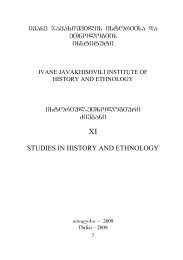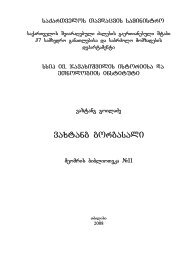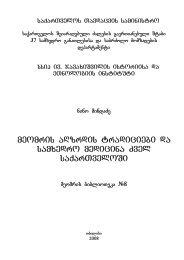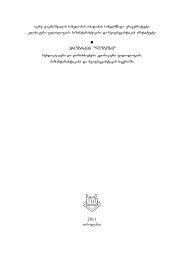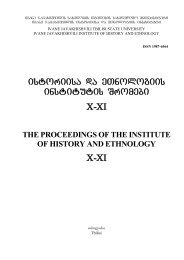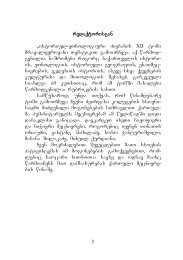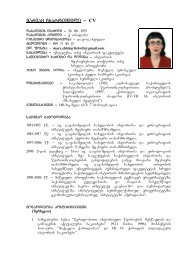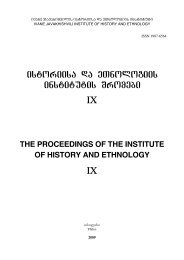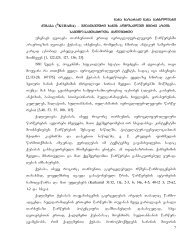programa "logosi"
programa "logosi"
programa "logosi"
Sie wollen auch ein ePaper? Erhöhen Sie die Reichweite Ihrer Titel.
YUMPU macht aus Druck-PDFs automatisch weboptimierte ePaper, die Google liebt.
the text of the fable). The form tabrinni- in the Hurrian version of this text<br />
corresponds to the Sumerogram SIMUG ‘blacksmith’ in its Hittite version.<br />
Sumerograms are words that were written in Sumerian in an ancient text,<br />
but pronounced in Hittite or another vernacular language, much like the<br />
abbreviation lb. is pronounced "pound" in an English text. According to an<br />
Assyriological convention, Sumerograms are capitalized in transliteration.<br />
Another occurrence of the Sumerogram SIMUG in the Hittite version of<br />
the same passage corresponds to Hurr. taballi-. Formally speaking, both<br />
Hurrian words can be derived from the verbal stem tav- ‘to cast (metal)’,<br />
which corresponds to Hitt. lahu-, otherwise attested with the meaning ‘to<br />
pour (liquids)’. The stem alternation tav-/tab- in Hurrian can be compared<br />
with the similar stem alternation tōb-/tōv- ‘incantate’ (Giorgieri 2002: 68:<br />
fn. 5). It is possible that this alternation is merely graphic rather than phonetic,<br />
cf. the Hurrian spelling ta-wa a -ar[-na] for the royal title Tabarna discussed<br />
above (Bo 4790.9) , or the alternation between Hurr. ku-wa a -hi and<br />
Hitt. ku-pa-hi ‘a type of head-gear’.<br />
Yet another derivative of the same root, attested as Hurr. tabiri- ‘one<br />
who casts’ was independently borrowed into Sumerian, yielding Sum. tabira<br />
/ tibira ‘copper-worker’ (Wegner 2000: 15 with ref.). As for Hurr. taballi-<br />
‘blacksmith’, this noun may well have been preserved in the Neo-<br />
Assyrian toponym Tabal, used with reference to a Luwian Kingdom in Central<br />
Anatolia that abounded in copper resources (thus Neu.1996: 150, fn.<br />
410).<br />
The Armenian form darbin could not be borrowed from Hurrian since<br />
this language had secondarily devoiced its word-initial-stops, and therefore<br />
one would expect **tarbin in Classical Armenian. A natural assumption<br />
that can be made on historical grounds is that the Armenian form came from<br />
the Urartean language, which is closely related to Hurrian. This hypothesis<br />
renders the borrowing phonetically possible: we know that the cuneiform<br />
signs for voiceless, voiced and "emphatic" stops were contrastively used in<br />
Urartean orthography in word-initial position. Thus one can hypothesize<br />
that Urartean contained the form *dabrinni (vel sim.) ‘blacksmith’ that was<br />
borrowed into Pre-Classical Armenian, where it underwent the expected<br />
metathesis –br- > *-rb- (on which see e.g. Schmitt 1981: 72-3). The list of<br />
Urartean borrowings into Armenian, presented in Jahukian 1987: 427 ff.,<br />
can be now extended by an additional item.<br />
The comparison between the reconstructed IE. *dhabhro- (including<br />
Arm. darbin), and Sum. tabira- / tibira- has been made in Whittaker 1998:<br />
135. The author, who did not mention the Hurrian forms as a tertium comparationis,<br />
used this comparison as one of many equations meant to demonstrate<br />
that a considerable part of the Sumerian lexicon was borrowed from<br />
268





